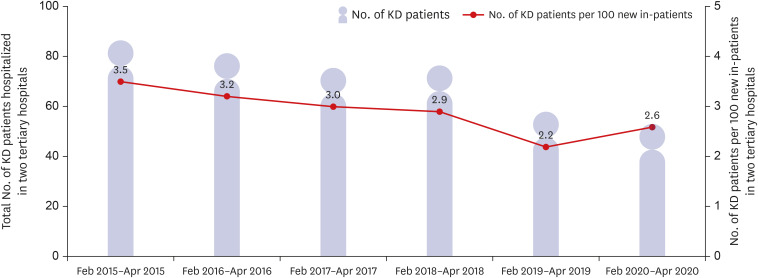Kawasaki disease (KD) is an acute febrile systemic vasculitis of early childhood with a predilection for the coronary arteries. Since the recent reports from the North America and European countries on Kawasaki-like disease or multisystem inflammatory syndrome in children (MIS-C) possible association with coronavirus disease-19 (COVID-19),1,2 we explored whether this has been observed in Korean children. The incidence of KD in Korea is estimated to 217.2 per 100,000 children less than 5 years old, 10-30 fold higher than that of KD in North America and Europe.3 The first patient with COVID-19 in Korea was identified on January 20, 2020, the first pediatric patients was identified on February 19, and the outbreak surge occurred at the end of February.4 As of May 18, 2020, the number of pediatric cases (≤ 19 years) confirmed with positive severe acute respiratory syndrome coronavirus-2 (SARS-CoV-2) polymerase chain reaction (PCR) result was 768 out of 11,065 (6.9%) in the nation and among those, no case of Kawasaki-like clinical manifestations has been documented.5 In addition, the number of patients with KD among the total new in-patients were searched in two tertiary referral centers in Seoul, Korea during each three months (February to April) from 2015 to 2020 (Fig. 1). A total of 429 children were diagnosed as KD among 14,714 new in-patients during the period. On average, more than 90% of the KD patients were from 0-5 year-age group. For a fair comparison, the proportion of KD patients hospitalized in these two hospitals out of all KD patients in the nation per year was examined. The total numbers of KD patients in the nation per year were retrieved from the Health Insurance Review and Assessment Service website, and proportions were calculated.6 These proportions were similar with a range of 1.0% to 1.4% during each three months (February to April) from 2015 to 2019. There was no significant increase in KD-related hospitalization. The numbers of children with KD per 100 new in-patients were 3.5 in 2015, 3.2 in 2016, 3.0 in 2017, 2.9 in 2018, and 2.2 in 2019, and 2.6 in 2020 (February to April). Despite 50 years of search for viral causality, the etiology of KD remains unknown. For example, coronavirus NL63, 229E and even bocavirus have been suggested for the association with KD but failed to clarify the definite association.7,8 Epidemiologic reports on a sudden rise in MIS-C or Kawasaki-like disease, mainly in older children, are concerning. Direct detection of SARS-CoV-2 from a patient with MIS-C might suggest its contribution to its clinical manifestation. As the COVID-19 pandemic expands over time, however, the presence of the specific SARS-CoV-2 antibody alone may not be sufficient to explain the causal relationship in which COVID-19 evokes an abnormal immunological response leading to MIS-C. Given differences in race-specific incidence of KD in the past, global collaborations should be established to investigate the increase in the occurrence of MIS-C associated with COVID-19. A systematic study with a prudent approach is needed to further elucidate the association.
Fig. 1. The number of children hospitalized with a diagnosis of KD in two tertiary referral centers in Seoul, Korea during each three months (February to April) from 2015 to 2020. The human body shape bar indicates the total number of KD patients and the number on each closed circle indicates KD patients per 100 new in-patients in the corresponding year.
KD = Kawasaki disease.
Footnotes
Disclosure: The authors have no potential conflicts of interest to disclose.
- Conceptualization: Kim YJ, Choi EH.
- Data curation: Park H, Choi YY, Kim YK, Yoon Y, Kim KR.
- Writing - original draft: Kim YJ.
- Writing - review & editing: Choi EH, Park H.
References
- 1.Jones VG, Mills M, Suarez D, Hogan CA, Yeh D, Segal JB, et al. COVID-19 and Kawasaki disease: Novel virus and novel case. Hosp Pediatr. 2020 doi: 10.1542/hpeds.2020-0123. Forthcoming. [DOI] [PubMed] [Google Scholar]
- 2.Verdoni L, Mazza A, Gervasoni A, Martelli L, Ruggeri M, Ciuffreda M, et al. An outbreak of severe Kawasaki-like disease at the Italian epicentre of the SARS-CoV-2 epidemic: an observational cohort study. Lancet. 2020 doi: 10.1016/S0140-6736(20)31103-X. Forthcoming. [DOI] [PMC free article] [PubMed] [Google Scholar]
- 3.Kim GB. Reality of Kawasaki disease epidemiology. Korean J Pediatr. 2019;62(8):292–296. doi: 10.3345/kjp.2019.00157. [DOI] [PMC free article] [PubMed] [Google Scholar]
- 4.Korean Society of Infectious Diseases; Korean Society of Pediatric Infectious Diseases; Korean Society of Epidemiology; Korean Society for Antimicrobial Therapy; Korean Society for Healthcare-associated Infection Control and Prevention; Korea Centers for Disease Control and Prevention. Report on the epidemiological features of coronavirus disease 2019 (COVID-19) outbreak in the Republic of Korea from January 19 to March 2, 2020. J Korean Med Sci. 2020;35(10):e112. doi: 10.3346/jkms.2020.35.e112. [DOI] [PMC free article] [PubMed] [Google Scholar]
- 5.Korea Centers for Disease Control and Prevention. The update of COVID-19 in Korea as of May 18. [Updated 2020]. [Accessed May 18, 2020]. https://www.cdc.go.kr/board/board.es?mid=a20501000000&bid=0015#.
- 6.Health Insurance Review and Assessment Service. Medical statistics information. [Updated 2020]. [Accessed May 26, 2020]. http://opendata.hira.or.kr/op/opc/olap4thDsInfo.do.
- 7.Lehmann C, Klar R, Lindner J, Lindner P, Wolf H, Gerling S. Kawasaki disease lacks association with human coronavirus NL63 and human bocavirus. Pediatr Infect Dis J. 2009;28(6):553–554. doi: 10.1097/inf.0b013e31819f41b6. [DOI] [PubMed] [Google Scholar]
- 8.Shirato K, Imada Y, Kawase M, Nakagaki K, Matsuyama S, Taguchi F. Possible involvement of infection with human coronavirus 229E, but not NL63, in Kawasaki disease. J Med Virol. 2014;86(12):2146–2153. doi: 10.1002/jmv.23950. [DOI] [PMC free article] [PubMed] [Google Scholar]



